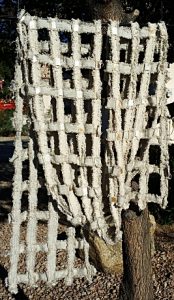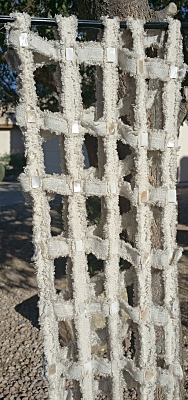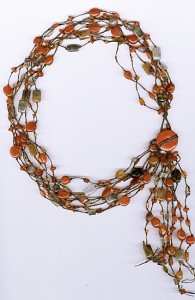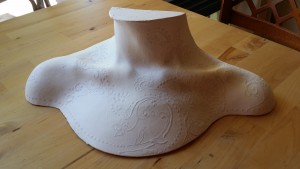 A month or so ago I posted a progress report on a scarf project. It’s finally finished. I may or may not sell it, but I’d like to wear-test it first.
A month or so ago I posted a progress report on a scarf project. It’s finally finished. I may or may not sell it, but I’d like to wear-test it first.
Materials: natural gray-tan linen, bias-cut cotton, cotton-polyester thread, rectangular mother of pearl beads.
It not only came out close to my initial sketch, it’s even better. I’m usually ready to sell pieces the moment I finish and document them, but I might hold onto this one for a while.
Plus, I’m not sure I *can* sell it, not for the $200 minimum I’d need to recoup materials and labor. I certainly can’t sell it locally, and I’ll rant for a bit on the reason why:
The $200 scarf and the neighborhood boutique.
A decade ago I could have placed this scarf in at least four galleries/boutiques in Arizona. And probably would have sold versions of it for between $300 to $360, at the rate of three or four a month. Possibly more.
Vendors like that still exist in the Southwest, but not many, and getting into them is as much or more of a challenge than snagging a literary agent’s eye.
I love my local clothing and accessory boutiques, but I can’t afford to buy from them often. The internet, the economy, and public buying habits are killing many of the local retailers of fine & funky clothing.
‘Fast fashion’ is affordable and easy to get online or at local malls (even if a lot of it is based on stolen designs and poor quality construction). Outlet stores undercut even the fast fashion outlets. Cheap knockoffs from Asia drive the pulse of the ever-changing market.
The phrase “I spent 25 hours on this scarf” is met not with approval but disbelief, as if why would I waste time on such a thing. Couldn’t I just have bought it from China? (By the time this post is a week old, I probably can.)
I made it because I wanted to see if I could make it. If I sell it, I want at least a pittance to compensate for replacing the raw materials…and I’m even going easy on my labor.
I can’t afford to ‘buy local’ on lots of new clothing and accessories (I’m a thriftstore adventurer, not a Barneys or Macy’s full-price labelhound.) So I can’t afford to sell locally, either. I’m pulling back from local retail markets, and not even trying to place work in higher-end regional or national galleries. That would require ramping up to wholesale production levels, a workload I simply can’t do right now.
 Last year I placed some of these stone and cord convertible necklaces in a local boutique food & drink purveyor, because the owner wanted to offer accessories that fit her store’s vibe. This store is in an established and fairly busy open-air shopping mall, in one of the highest-rent areas of Phoenix. Neighboring stores include trendy, very upscale brands and medium to expensive restaurants. I see the cars in the parking lot, and can estimate the net worth of their drivers.
Last year I placed some of these stone and cord convertible necklaces in a local boutique food & drink purveyor, because the owner wanted to offer accessories that fit her store’s vibe. This store is in an established and fairly busy open-air shopping mall, in one of the highest-rent areas of Phoenix. Neighboring stores include trendy, very upscale brands and medium to expensive restaurants. I see the cars in the parking lot, and can estimate the net worth of their drivers.
First problem: the store owner needed me to come down on the first necklace prices. $150 wholesale was too much, she couldn’t sell them for $250 -300 retail. I pulled back the expensive twelve-strand necklaces and brought out some four-strand pieces with lesser stones. I said: “I have more affordable designs. What’s your wholesale price point?”
No more than $80 or $90 retail, she estimated, which left me earning a consignment of $40 to $50. I let her keep two necklaces for show, along with this neckform that I ornamented from a friend’s plaster casting.
Three months later there were no nibbles on the necklace, or even the neckform. “People liked them, they just don’t want to pay much right now,” the boutique owner explained.
I can’t blame her: she knows her customers. I know her customers. They’ll spend $$$ on her products, because those are worth every penny. But my jewelry looks simple, and isn’t loaded down with gold or faceted gems. So the assumption is ‘Costume jewelry=cheap=probably plastic=I can buy that at the mall or on Etsy.’
Which is why I’m moving most of my sales platforms online, where I’ll be paying lower consignment fees and have a hope of getting paid.